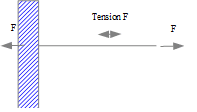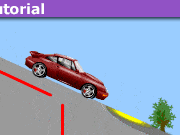Frequently Made Errors in Mechanics: Forces
Entire List for Frequently Made Errors Series
Notation: On this page, a circumflex signifies an average.
Table of Contents
1. Forces as vectors
A force is a vector, i.e. has magnitude and direction. But it also has a point of application, which vectors, in general, do not have.
For a force applied to a rigid body, the precise point of application does not matter; instead, the line of action suffices. This is the straight-line through the point of application, in the direction of the force. The force applied at any point in that line would have the same effect.
2. Tension and Compression
X “If a light string is pulled with a force of F at each end, the tension force in the string is 2F”
If you pick a point in a string and consider the portions on either side of that point as separate bodies, the tension at that point is the magnitude of each of the pair of forces, action, and reaction, with which each portion pulls the other.
✓“If a light string is pulled with a force of F at each end, the tension in the string is F”
Note that this includes e.g. a string pulled with force F at one end and tied to a wall at the other. The wall pulls on the string with force F.
3. Average force
“Work = force × distance,
X Therefore average force can be calculated as work done divided by distance”
What is meant by “average force”? Average acceleration is the change in velocity divided by the elapsed time:
##\hat {\vec a} = \Delta \vec v/\Delta t##
A sensible definition of average force is such that ##\hat {\vec F} = m\hat {\vec a}##:
✓##\hat {\vec F} = m\hat {\vec a} = m\Delta \vec v/\Delta t = \Delta \vec p/\Delta t##
where ##\vec p## is momentum.
If the force happens to be constant then this will produce the same numerical answer as work/distance, but only in that case.
It is possible to define averages in different ways, provided it is made clear. One could specify “force averaged over distance”. But there is another reason for rejecting the work/distance calculation. The completely correct form of Work = force × distance involves vectors:
##\Delta E = \int \vec F.\vec{ds}##, ##\vec{\Delta s} = \int \vec{ds}##
Turning that into a division results in dividing by a vector, which is not a defined operation:
X ##\hat {\vec F} = \Delta E/\vec{\Delta s}##
SHM example
“A mass m collides elastically at speed v with a rubber pad of spring constant k. What is the average force bringing the mass to stationary?”
The distance x the pad is compressed is given by
##\frac 12 m v^2 = \frac 12 k x^2##
##x = v\sqrt{\frac mk}##
If we calculate the average force from this we get
##\hat {\vec F_{dist}}=\frac 12 v\sqrt{mk}##
The time to maximum compression is ##T=\frac{\pi}2\sqrt{\frac mk}## . Dividing this into the momentum change mv gives
##\hat{\vec F} = \frac 2{\pi}v\sqrt{mk}##
4. Available force equations
In two dimensions there are three force equations available. These are usually taken as linear force sums,##\Sigma F_x=m a_x##, in (any) two orthogonal directions, plus a moment sum about some reference point; but there are other valid choices:
The two linear equations do not need to be orthogonal; they can be based on any two directions that are not parallel.
One linear equation and moments about two points also works, provided the line through the two points is not orthogonal to the linear choice.
Equations for any other linear direction or moments about any other point can be deduced from the three chosen, so provide no further information
A linear force can be thought of as a moment about a point at infinity (the point being infinitely far away in a direction orthogonal to the linear direction taken).
5. Sign Conventions and Gravity
A common practice is to take ‘up’ as positive. Taking down as positive is fine, but it is advisable to be consistent, using the same convention for displacements, velocities and accelerations. Defining some variables one way and some the other is valid but tends to confuse.
X “If up is positive then the force due to gravity is -mg”
“g” is just a variable name, commonly reserved in mechanics for gravitational acceleration at Earth’s surface. Writing the force as -mg is valid, but in effect adopts an inverted convention for the variable g, i.e. makes g positive downwards. It is more consistent to take the gravitational force as +mg and, when plugging in numbers, provide a negative value for g.
✓ “If up is positive then the force due to gravity is mg, unless g is defined positive down”
That said, it is extremely common to take g positive down but all else positive up.
6. Force and Work
X “The work done by a force on a body is the magnitude of the force multiplied by the distance the body moves.”
That is only true if the force is constant and the distance the body moves is in the same direction as the force.
In general,
✓ Work = ##\int \vec F. \vec{ds}##
If the force is constant, this simplifies to ##\vec F.\vec{\Delta s}##.
If the distance the body moves is entirely in the direction of the constant force, this further simplifies to ##F \Delta s##, where ##F## and ##\Delta s## are signed scalars.
6.1 Work done by the normal force
X “The normal force does no work”
That is true if the surface is not moving along its perpendicular, but consider a standing person mass m riding up an escalator through a height h. The vertical displacement is h and the normal force is -mg, so the work done is -mgh (g being negative).
Example: Riding an escalator
It gets a little more complicated if the person is also walking up the escalator.
X “If a person is walking up the escalator at a constant speed then the normal force exceeds mg”
If the normal force were to exceed mg then the person must accelerate.
Suppose the step height is s, and in the time the person moves up one step the escalator rises height r. Consider the person as consisting of a point mass m atop an extensible massless leg.
Since the mass is not accelerating, the compression in the leg is |mg|. The escalator rises height r, doing work –mgr. In the same time, the leg extends by length s, doing work –mgs.
6.2 Infinitesimal work
“What is the minimum work needed to move a box weight W on the floor at point A to a point B on the floor distance s away? The floor is level and has a coefficient of kinetic friction ##\mu_k##.”
The minimum force needed to drag the box is when it is applied at angle ##\tan^{-1}\mu_k##,
X so the minimum work done is ##\frac{Ws\mu_k}{1+{\mu_k}^2}##
The minimum work does not necessarily correspond to the minimum force. The work can be lower if a greater force is applied but the force advances a much shorter distance. In the extreme case, a force advancing an infinitesimal distance does infinitesimal work.
In the problem above, a force exceeding W by a tiny amount, acting over a tiny distance, is sufficient to lift the box clear of the floor and hold it clear. A second force acting horizontally over a tiny distance accelerates the box to a tiny speed. No further work, just adequate time, is required to reach point B. In principle, even these small quantities of work might then be recoverable in bringing the box to rest and lowering it to the floor.
✓The work required to move the box is arbitrarily small
Masters in Mathematics. Interests: climate change & renewable energy; travel; cycling, bushwalking; mathematical puzzles and paradoxes, Azed crosswords, bridge









Leave a Reply
Want to join the discussion?Feel free to contribute!